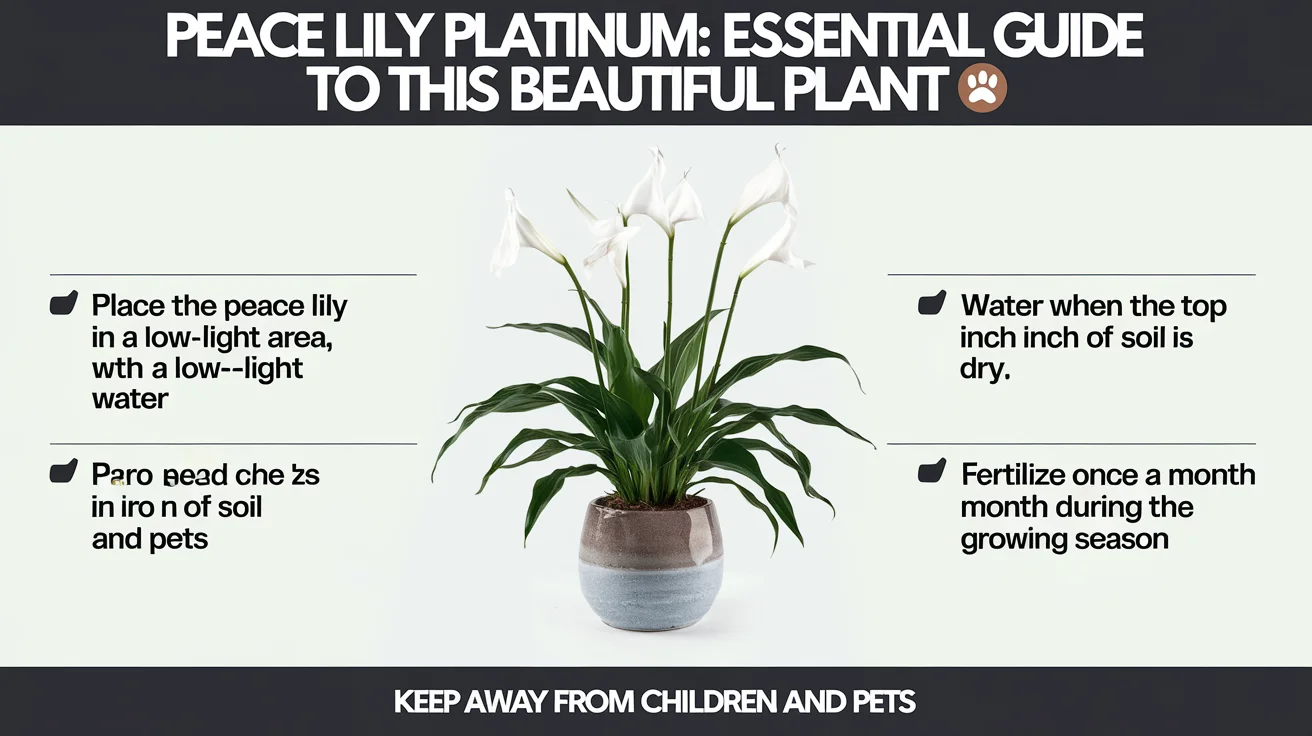Your interiors with their impressive white flowers and green leaves. This houseplant also sanitizes the air in the room and brings peaceful feelings to its owner. So in today’s article, we will cover all you need to know about peace lily platinum, including its features, how to care for the plant, and potential issues. If you have been thinking of getting a peace lily for your home or you have one, then this is the guide for you because it touches on how to properly take care of the plant.
Gaining insight into the Peace Lily Platinum
This is one of the varieties of the Spathiphyllum plant known to many for its lovely white flowers and dark green leaves. This specific variety has gained a lot of popularity among plant farmers due to its ability to grow hugely, some even reaching as high as 4 feet in height. The large, shiny leaves offset the stunning white spathes. They are often called flowers, but they aren’t. They are structures that mimic tiny flower buds. It looks classic. It has beautiful flowers. This species can remove carbon monoxide, formaldehyde, and benzene from the air, among other pollutants.

Caring for Your Peace Lily Platinum
Its management is easy. But one must know how to help this flowering plant thrive.
Light Conditions
Peace lilies grow well in medium to bright indirect sun as well as in low light. However, too much sunlight should be avoided as it burns the leaves. In this case, try to shift the plant to a spot where it gets bright light but no scorching sun directly on it.
Watering
Keeping the peace lily watered is one of the most important factors. These plants generally like the soil to be moist at all times but will usually withstand dry conditions for brief periods. To learn when to water, feel the soil at the top one inch. If it is dry, then that is the right time to water. Too much water should also be avoided, as this can result in root rot. Room temperature water is helpful because it does not shock the roots.
Humidity and Temperature
Peace lilies enjoy high humidity levels; thus, they are best suited for places such as bathrooms or kitchens. If you live in a dry climate, you may want to consider misting the leaves from time to time or placing a humidity tray underneath the pot. With regard to temperatures, peace lilies grow best within a temperature range of 65 degrees Fahrenheit and 85 degrees Fahrenheit (18 to 29 degrees Celsius). Make sure to protect them from drafty conditions, heating vents, and cold windows.
Soil and Fertilization
For peace lily platinum, the potting mix ought to be quite porous. Either a houseplant mix or a mixture of peat, perlite and potting soil is suitable. After that you should fertilize the plant once in 6 to 8 weeks during the period of growth (spring and summer) with a general liquid fertiliser which should be diluted to halfway. In the fall and winter months, when the plant slows its growth, do not fertilise.
Problems and Solutions
As this is no different with the other houseplants,this plant has a few issues that may creep in. Following are some issues that may occur and their fixes:
Yellow leaves of the plant.
Yellowing of the leaves denotes that the peace lily plant may be overwatered, underwatered or is deficient in some nutrients. Make sure you water the plant appropriately and inspect the drainage for the soil. If the leaves are turning yellow, it may be caused by nutrition deficiency. Change your fertilisation rhythm.
Brown tips of peace lily leaves are about to fall off.
Brown tips are usually dried areas on the edges of the leaves due to lack of moisture generally from dry air. Brown leaf tips are often caused by low humidity or too little water. Take the necessary steps to increase the humidity levels relatively fast. Water the plant or do not allow the soil to dry out completely.
Pests
It’s been reported that pests that are frequently found on peace lily platinum are spider mites and aphids. Always examine the stems and leaves of the plant for any infestations. In case you notice an infestation, you should treat the plant with insect soap or neem oil to get rid of the pests.
Propagation Techniques
Any practical process of propagating peace lily platinum outwards help one look for ways to compliment or aggravate a friend dependency on plants. It is preferable to nip this type of plant by splitting the Nodes of the mother plant. Here is how it is done:
The first step is to pull the plant out of its pot. The next step is to systematically break down the root ball in sections making sure each section contains leaves and roots. Each part is put into a separate pot containing moist soil.
Benefits of Peace Lily Platinum
Also, this type of peace lily platinum is more than just a good-looking plant:
- Anti-pollution: Peace lilies can absorb harmful toxins. This explains their ability to combat indoor pollution.
- Low Maintenance: This plant needs little care. Nairobi’s fast growth troubles those without gardening experience.
- Beauty: Adding Howardia alba, or peace lily, enhances the décor. Its leaves and flowers are beautiful.
Conclusion
In conclusion, the peace lily platinum is the best indoor plant. It looks great, purifies the air, and is easy to care for. Knowing the exact light, water, humidity, and soil your peace lily needs will help you grow a healthy, beautiful plant. With this care, your peace lily will bloom. It will have lush, green leaves. This will create a soothing environment at home. Both experienced and novice indoor gardeners appreciate such improvements to the peace lily platinum. Indulge in the beauty of this wonderful flower and its health benefits in the house!





